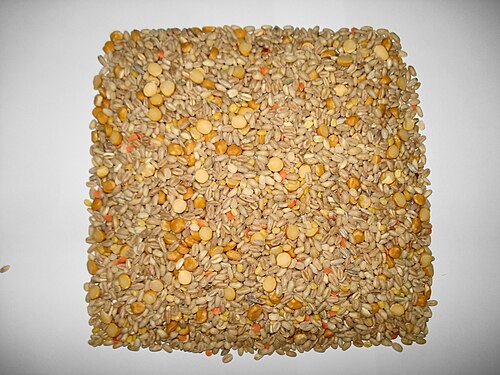 Hyderabadi mutton haleem garnished with cilantro, egg, fried onion, and lime | |
| Alternative names | Hyderabadi harees |
|---|---|
| Place of origin | India |
| Region or state | Hyderabad,Telangana |
| Associatedcuisine | Indian |
| Created by | Originated from theChaush (Hyderabadi Arabs)[1] |
| Main ingredients | Pounded wheat,lentils,goat meat,ghee,dried fruit andsaffron |
| This article is part of the series on |
| Indian cuisine |
|---|
 |
Regional cuisines
|
Ingredients, types of food |
Hyderabadi haleem (/ˈhaɪdərəbɑːdiːhəˈliːm/) is a type ofhaleem popular in theIndian city ofHyderabad. Haleem is astew composed of meat, lentils, and pounded wheat made into a thick paste. It is originally anArabic dish and was introduced to theHyderabad State by theChaush people during the rule of theNizams (the former rulers of Hyderabad State). Local traditional spices helped a unique Hyderabadi haleem evolve, that became popular among the native Hyderabadis by the 20th century.
The preparation of haleem has been compared to that ofHyderabadi biryani. Though Hyderabadi haleem is the traditionalhors d'oeuvre at weddings, celebrations and other social occasions, it is particularly consumed in the Islamic month ofRamadan duringIftar (the evening meal that breaks the day-long fast) as it is high incalories. In recognition of its cultural significance and popularity, in 2010 it was grantedGeographical Indication status (GIS) by the Indian GIS registry office,[2] making it the first non-vegetarian dish in India to receive this status. In October 2022, Hyderabadi haleem won 'Most Popular GI' award in the food category, that was chosen through a voting system that was conducted by the Department for Promotion of Industry & Internal Trade (under theMinistry of Commerce and Industry).[3]
Haleem originated as anArabic dish[1][4] with meat and pounded wheat as the chief ingredients. It was introduced to Hyderabad by theArab diaspora during the rule of the sixth Nizam,Mahbub Ali Khan, and later became an integral part ofHyderabadi cuisine during the rule of theseventh Nizam,Mir Osman Ali Khan.[5][6] Sultan Saif Nawaz Jung Bahadur, an Arab chief fromMukalla,Hadhramaut, Yemen, who was among the seventh Nizam's court nobility, popularised it in Hyderabad.[1][7] Addition of local flavours to the original recipe resulted in a taste distinct from other types of haleem.[8][9]

Traditionally, Hyderabadi haleem is cooked on a low flame offirewood for up to 12 hours in abhatti (acauldron covered with a brick and mudkiln). One or two people are required to stir it continuously with wooden paddles throughout its preparation. For home-made Hyderabadi haleem, aGhotni (a wooden hand masher) is used to stir it until it reaches a sticky-smooth consistency, similar tominced meat.[10][11]

The ingredients include meat (eithergoat meat, beef or chicken); pounded wheat;ghee—(milk fatrendered frombutter, also called clarified butter); milk;lentils; ginger and garlic paste;turmeric; redchili pepper spices such ascumin seeds,caraway seeds (shah zeera),cinnamon,cardamom,cloves,black pepper,saffron,jaggery,natural gum,cubeb (kabab cheeni); anddry fruits such aspistachio,cashew,fig andalmond. It is served hot topped with a ghee-basedgravy, pieces oflime, choppedcoriander,sliced boiled egg andfried onions asgarnish.[5][12][13][14]
Different variants have been introduced catering to regional tastes and requirements. Ameethi (sweet) variant of haleem is consumed as breakfast by theArab diaspora inBarkas neighbourhood of the city.[15] The chicken variant is less popular, even though it is lower priced. A vegetarian version of haleem, in whichdry fruits and vegetables are substituted for goat meat, is available at someeateries in Hyderabad.[16]
| External image | |
|---|---|
 A slideshow of Hyderabadi haleem preparation images. Published onFlickr A slideshow of Hyderabadi haleem preparation images. Published onFlickr |
Hyderabadi haleem is a high calorie dish which gives instant energy as it contains slow-digesting and fast-burning ingredients.[17][18] It also contains dry fruits rich inanti-oxidants.[12][19] The meat and dry fruits make it a high protein food. A new low-cholesterol variety by usingemu meat, rich inminerals, phosphorus and vitamins, was introduced in 2013.[20][21] TheGreater Hyderabad Municipal Corporation (GHMC), a local civic body that monitors health and safety regulations in the city, has set up hygiene and quality standards to be followed by the eateries selling it.[22]

Hyderabadi haleem is regarded as an international delicacy.[23][24] In Hyderabad, the dish is often consumed at celebratory events such as weddings.[17] It is consumed especially duringIftaar, the evening meal following the day-long fast, observed by Muslims during the month ofRamadan.[25][26][27][28]
Pista House, Hotel Shadab, Paradise,Shah Ghouse Café, Cafe 555, Grill 9, Pariwar's Have More, Cafe Bahar, Chicha's, Peshawar, Sarvi and Grand Hotel are some of the many places to try Haleem in Hyderabad[29][30]
In Hyderabad and neighbouring areas, the month of Ramadan is synonymous with Hyderabadi haleem.[31][32] During the 2014 Ramadan season,₹ 5 billion worth of Hyderabadi haleem was sold in the city,[33] and an additional 25,000 people were employed in the preparation and sale of haleem.[34] The connoisseurchefs are paid salaries of up to₹100,000 (US$1,200) a month plus benefits,[35] As of 2011, during Ramadan there were 6,000 eateries throughout the city that sold haleem (70% of which are temporary until Ramadan ends),[36][37] and 28% of Hyderabadi haleem produced in the city was exported to 50 countries throughout the world.[36]
Sanjeev Kapoor, an entrepreneur ofIndian cuisine, mentions in his bookRoyal Hyderabadi Cooking that the preparation of haleem in Hyderabad has become an art form, much like theHyderabadi biryani.[38] In 2010 Hyderabadi haleem was awarded Geographical Indication status by the IndianGI registry office. It became the first meat product of India to receive a GI certification.[18][39] This means that a dish cannot be sold as Hyderabadi haleem unless it meets the necessary standards laid down for it.[37][40]
{{cite book}}:|work= ignored (help){{cite journal}}:Cite journal requires|journal= (help){{cite book}}:|work= ignored (help)